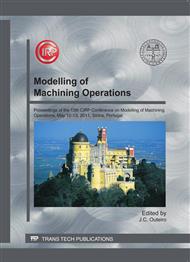[1]
J. Rech, H. J., Hamdi and S. , H. and Valette, S., 2008, Workpiece Surface Integriy, Chapter from Machining Fundamentals and recent Advances, J. P. Davim editor, Springer-Verlag London (2008).
Google Scholar
[2]
K.J. Stout, K. J., P.J Sullivan, P.J., W.P. Dong, W.P., E. Mainsah, E.,N. Luo, N., T. Mathia, T. and H. Zahouani, H., 1993, The development of methods for the characterization of roughness in three dimensions, University of Birmingham, Inglaterra, University of Birmingham Press, (1993) p.359.
Google Scholar
[3]
B. Griffiths, B., 2001, Manufacturing Surface Technology, Penton Press, London, (2001) p.233.
Google Scholar
[4]
R.A. Waikar, R.A. and Y.B. Guo, Y.B., 2008, A comprehensive characterization of 3D surface topography induced by hard turning versus grinding, Journal of Materials Processing Technology, 197, (2008), pp.189-199.
DOI: 10.1016/j.jmatprotec.2007.05.054
Google Scholar
[5]
H.K. Tönshoff, C. Arendt and R. Amor, Cutting of hardened steel, Ann. CIRP,Vol. 49, n. 2 (2000), pp.547-66.
DOI: 10.1016/s0007-8506(07)63455-6
Google Scholar
[6]
W. Grzesik, W., J. Rech, J. anand T. Wanat, T., 2007, Surface finish on hardened bearing steel parts produced by super hard and abrasive tools, International Journal of Machine Tools and Manufacture, Vol. 47, (2007), p.255–262.
DOI: 10.1016/j.ijmachtools.2006.03.018
Google Scholar
[7]
H. Akima, H., 1978, A method of bivariate interpolation and smooth surface fitting for irregularly distributed data points, ACM Transactions on Mathematical Software, volVol.2, (1978), pp.148-159.
DOI: 10.1145/355780.355786
Google Scholar
[8]
G.F. Batalha, G. F. and M. Stipkovic Filho, M., 2001, Quantitative Characterization of the Surface topography of cold rolled sheets - new approaches and possibilities. Journal of Materials Processing Technology, vVol. 113, n. 1, (2001), pp.732-738.
DOI: 10.1016/s0924-0136(01)00607-0
Google Scholar
[9]
W. Grzesik, T. Wanat, Surface finish generated in hard turning of quenched alloy steel parts using conventional and wiper ceramic inserts, International Journal of Machine Tools & Manufacture, Vol. 46, (2006), p.1988–1995.
DOI: 10.1016/j.ijmachtools.2006.01.009
Google Scholar


